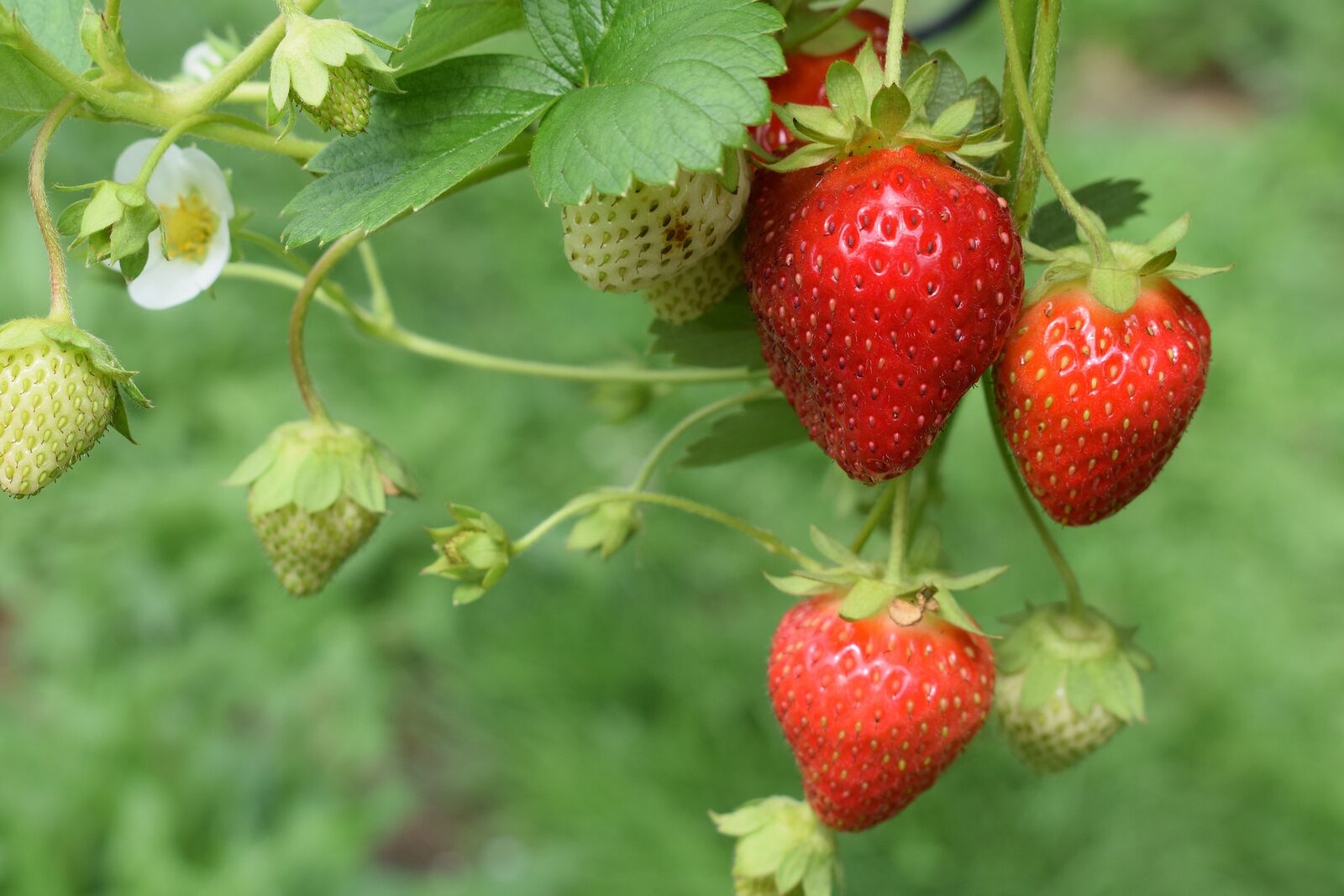Fertilization is essential so that you can expect a rich harvest from your strawberry plants. It’s important to know a few things about strawberries because they need different nutrients than other plants in your garden. We give you tips on fertilizing strawberries with organic fertilizers. You can find out which fertilizers are suitable here in this article.
As a strawberry lover, there’s nothing quite like picking juicy, sun-ripened berries straight from your own garden. To get the most out of your strawberry patch, it’s important to use the right organic fertilizer. Organic options enrich the soil with nutrients vital for vigorous plants, loads of flowers, bigger berries, and sweeter flavor.
In this article, I’ll cover the top 10 organic fertilizers for strawberries and provide tips on when and how to apply them. With the proper feeding you’ll be rewarded with the healthiest most productive strawberry plants possible.
Why Organic Fertilizer is Best for Strawberries
Organic fertilizers derived from plant and animal sources have key advantages for strawberries
- They release nutrients slowly over the growing season. This provides a steady supply of nourishment.
- Organic matter improves soil structure for better drainage and water retention.
- Beneficial microbes are introduced that keep plants strong and disease-resistant.
- Organic fertilizers won’t burn plants, even when applied heavily.
- There’s no risk of synthetic chemical residues on your edible berries.
When to Fertilize Strawberries
Timing is important when fertilizing strawberries:
- June-bearing: Mid to late summer after renovating beds. Avoid spring.
- Everbearing: When new leaves emerge in spring and again when berries start developing.
- Potted: Every 2 weeks during the growing season.
Feed established plants again after renovation and new plantings when they start flowering and fruiting.
How to Apply Organic Strawberry Fertilizer
- Work dry fertilizer into the top few inches of soil before planting.
- Side dress growing plants, sprinkle lightly around crowns, and water in well.
- Brew compost tea or liquid kelp to use as a foliar feed. Spray on leaves every 2-3 weeks.
- Top dress pots with worm castings or use compost tea.
Now let’s look at the 10 best organic fertilizers to use for flourishing strawberries:
1. Blood Meal
Blood meal provides a quick nitrogen boost. Sprinkle 1/4 cup per 10 square feet in early spring and again after renovating beds.
2. Alfalfa Meal
Alfalfa meal releases steady nitrogen and strengthens roots. Apply 1/4 cup per plant before planting and again in summer.
3. Fish Emulsion
Fish emulsion fertilizer adds nitrogen, phosphorus, and potassium. Use 2 tablespoons per gallon of water and feed every 3-4 weeks.
4. Cottonseed Meal
Cottonseed meal is a slow-release source of nitrogen and potassium. Use 1/4 cup per plant before planting and in midsummer.
5. Kelp Meal
Kelp meal contains micronutrients and growth promoters. Use 1-2 tablespoons per plant as a side dressing and to enrich compost tea.
6. Compost Tea
Compost tea introduces beneficial microbes and provides soluble nutrients. Apply weekly as a foliar spray during the growing season.
7. Worm Castings
Worm castings add nutrients and humus. Mix 1-2 inches into beds before planting. Side dress with 1/4 cup per plant monthly.
8. Soybean Meal
Soybean meal supplies nitrogen needed for green growth and fruit production. Apply 3-4 tablespoons per plant in early spring.
9. Bone Meal
Bone meal is rich in phosphorus for root growth and fruiting. Use 1/4 cup per plant before planting and again in spring.
10. Wood Ash
Wood ash raises pH and provides potassium, calcium, and magnesium. Sprinkle lightly around plants every 4-6 weeks.
Tips for Using Organic Fertilizers on Strawberries
- Always test soil pH and amend if needed before fertilizing.
- Rotate organic fertilizers each season to provide a variety of nutrients.
- Combine granular fertilizer with compost tea for balanced feeding.
- Pay close attention to application rates to avoid burning plants.
- Rinse foliage after applying fish emulsion or strong liquid feeds to avoid leaf burn.
- Supplement with calcium and iron if berries develop cracked caps or hollow centers.
The Takeaway
There are many wonderful organic fertilizer options for strawberries. Pay close attention to timing and rates. Combine granular, meal, and liquid feeds for the healthiest plants and biggest harvests. With the right organic nutrition, your strawberry patch will keep producing plenty of juicy berries for years to come.
Fertilizing single-bearing & everbearing strawberry plants: The right time
When fertilizing single-bearing and everbearing varieties, the timing and frequency are different. This is because everbearing varieties have a higher nutrient requirement due to the constant production of fruit.
- Strawberries that only bear one fruit are usually only fertilized once, in the middle of summer after the last harvest. It is best to fertilize these types of plants in the fall, not the spring. Spring fertilization doesn’t have much of an effect on your harvest because the strawberry flower buds were already set in the fall before they went dormant for the winter. To make sure the plant gets enough nutrients, you should make sure it has enough water.
- During the growing season, strawberry varieties that bear fruit all year are also fertilized several times. First, use slow-release organic fertilizer to feed the plants in the spring. If needed, give them organic liquid fertilizer at regular times after that. After that, you can use fertilizer every four to six weeks. It will still be helpful to use organic slow-release fertilizer like horn shavings on the plants even after the last harvest. Keep a close eye on your plants and act if you see any signs of a lack of something. Don’t fertilize too much, though, because that will make the strawberries more likely to get sick.
This article shows some well-known strawberry varieties and gives a list of single-bearing and everbearing varieties.
If you have any thoughts or questions, you can email us at [email protected] or tell us about your day on social media.
Sign up for this site or get the Fryd app for Android or iOS to get gardening tips all year long and get your beds ready for the best growth.
Fertilize strawberries correctly: They need these nutrients
For healthy growth, strawberry plants primarily require the main nutrients nitrogen, phosphorus and potassium. Trace elements like iron, boron, manganese, and zinc, as well as calcium and magnesium, are also needed in small amounts. Compared to most other crops that you probably grow in your garden, strawberries have a low nitrogen requirement. If they are over-fertilized, they react with excessive leaf growth at the expense of flower and fruit formation. Also, they are more likely to get sick. This doesn’t mean they don’t need nitrogen fertilizer, but they should only get a small amount. Much more important are nutrients like potassium and phosphorus, which are needed for flowers and fruits to grow and for the fruit to be good. Because of this, it is very important to know what fertilizers to use and how often to use them on strawberry plants.

Best Strawberry Fertilizers! – Garden Quickie Episode 139
FAQ
What is the best thing to feed strawberries?
What do coffee grounds do for strawberry plants?
- The Ultimate Guide to Growing Strawberries in Raised Beds - August 8, 2025
- No-Dig Garden Beds: The Easiest Way to Grow a Beautiful Garden - August 6, 2025
- How to Protect and Preserve Wood for Raised Garden Beds - August 6, 2025
